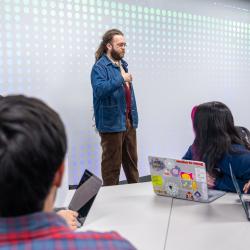Career Q&A with Senior Computer Science Major Kevin Liao
Liao sought University Career Center support for internship applications and interviews and landed a Capital One internship.

Why did you decide to study computer science at UMD?
When I took my first programming course during my sophomore year of high school, I already had a keen interest in language learning. I quickly realized that there are many similarities between the two—just like human languages have vocabulary and grammar, programming languages have algorithms and syntax. Both are communication tools.
I was also a competitive clarinet player—so with my love for classical music, linguistics and coding, I knew I wanted to dive deeper into computer science.
How have you taken advantage of opportunities on campus to pursue your career goals?
Last fall semester when I was actively looking for a summer internship, I went to as many career-related events as possible. These included company lobby days in the Iribe Center, company tech talks, coffee chats with campus recruiters, career fairs and even visits to corporate offices to hear from UMD alumni.
I also participated in technical resume reviews on campus. Resumes can be subjective, which is why I think it’s important to gather feedback from a few people before deciding what’s ultimately best for me.
When given the chance, I’ve mentored younger students as well through organizations such as App Dev Club, offering them insights and tips on how to land internships at top firms.
What kind of career guidance and one-on-one feedback did you receive from the University Career Center @ CMNS?
When I started to think more about internships as a sophomore, I didn’t quite know where to start. At that point, I didn’t know how to write a resume or how to take advantage of networking opportunities like career fairs, and I was just starting to activate my LinkedIn profile.
Advice from the University Career Center proved to be invaluable, and some of the most valuable one-on-one resume feedback I received included using the XYZ format for each role (e.g., I did X, using Y, as measured by Z), tailoring it to each role and keeping the information succinct in a way that it’s easy to read within a few seconds. I also received tailored feedback on how to make my LinkedIn profile stand out, such as including a professional headshot, using a background image that highlights who I am as a young professional, telling a story in my about section, etc.
I’ll admit—it can be daunting to navigate the prospect of looking for internships or full-time jobs. The University Career Center is definitely a great resource to support students in their journeys!
How was your experience as a Capital One intern?
When I first told people about my Capital One internship, they said, “You study computer science—what would you be doing at a bank?” I realized that, given the pace tech is moving, using a modern tech stack is essential to a bank like Capital One because of the sheer number of customers and transactions each day. For example, artificial intelligence and machine learning are critical to detect fishy transactions, and scaling databases (horizontally or vertically) is essential to avoid systems crashing due to large user traffic.
I’m interested in personal finance, investing and stocks, so interning at Capital One was a phenomenal opportunity to learn about how a financial services company leverages cutting-edge technology to change banking, thus enriching the experience of its customers.
The engineering culture at Capital One was great and really encouraged a collaborative, innovative environment. My intern pod primarily worked on a front-end internal application for backtesting, which deals with predicting future credit card policies and deploying them to Amazon Web Services.
What do you think your next stop after graduation will be?
After graduation, I plan to work in tech for a few years and get exposure to a wide variety of fields, such as full-stack development, the cloud, artificial intelligence and machine learning. By then, I hope to have a better idea on the overall trajectory of my career so I can decide whether to continue working or go back to school for an MBA or M.S. in computer science.
No one’s career path is black and white, and everyone’s journey is different. Above all, I believe it’s important to continue learning and keep our heads open. The tech industry moves very fast; new technologies, frameworks and programming languages are coming out regularly, so updating our skill sets is a must to stay relevant and keep our opportunities open.
What made you decide to become a “LinkedInfluencer,” and what advice do you have for fellow Science Terps looking for internships and jobs?
When I received the verbal offer from my Capital One recruiter over the phone, I was instantly on cloud nine. The countless hours applying to internships, networking, refining my resume, participating in mock interviews and doing online assessments had paid off.
My LinkedIn post announcing my Capital One internship received about 1,000 likes and 90,000 impressions. Since sharing my story, so many opportunities have come my way—including collaborating with the University Career Center, mentoring for computer science student organizations and nonprofits, and being named a 2024 WayUp Top 100 Intern. I’ve expanded my LinkedIn network and met some very passionate computer science students and industry professionals.
When it comes to looking for internships or jobs, one of my key pieces of advice is to start early and have a clear vision ofthe roles you hope to target. It’s more than just submitting a resume and interviewing. It’s networking, staying on top of industry trends (which skills are becoming more in demand and which companies are hiring) and knowing how to play the game (tailoring your resume to the job description and applying early).
If you’re an underclassman, one of the first ways you can start preparing is by building your portfolio. Your projects are a great way to demonstrate to a potential employer that you have certain skills. From there, start thinking about your resume. Think about how your past experience and skills make you a great candidate for a particular field. The University Career Center provides some excellent resources on how to write an effective resume, and you can also book a one-on-one session with the career advisors. Use platforms like LinkedIn, RippleMatch and Handshake to increase the chances of your application being seen or recruiters reaching out to you directly.
I would highly recommend checking out the resources the University Career Center offers, from how to write a resume, craft an elevator pitch, network at career fairs and more!
CMNS students have access to career advisors and programs that are personalized to their unique career interests in STEM fields. In this Q&A series, we are spotlighting how Science Terps are capitalizing on the resources, support and guidance that the University Career Center @ CMNS provides.
Make an appointment with University Career Center @ CMNS Program Director Becca Ryan or another University Career Center team member by visiting umd.joinhandshake.com or email cmnscareers@umd.edu with any career-related questions!







